Mandarin gobies are extremely popular reef fish. Moreover, they have the unique body shape and vibrant color patterns. Their outward eyes give a bit of an amphibian head-like appearance to them. Further, you can rear mandarin in your saltwater aquarium environment too. Let’s dive a bit deeper into the most exciting information about mandarin gobies.
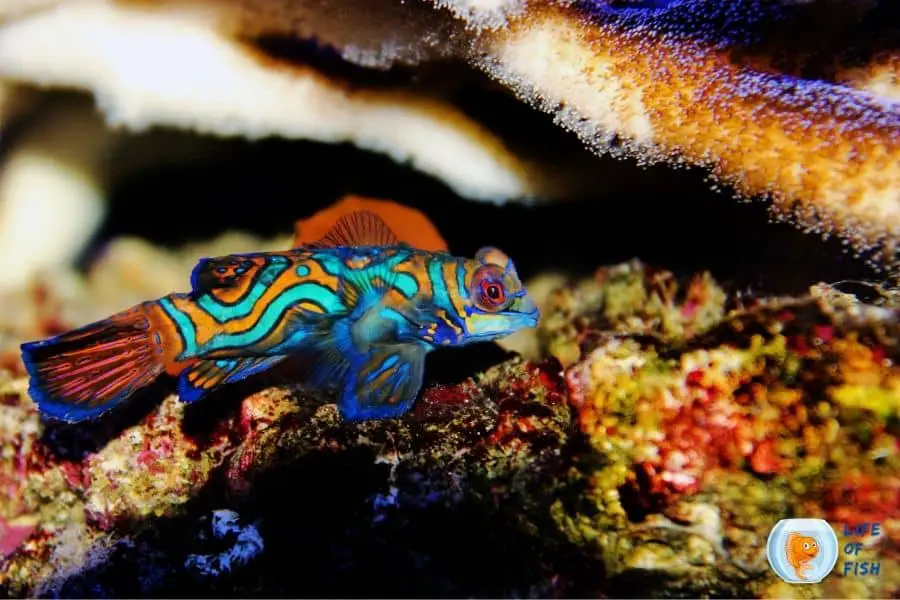
Are Mandarin gobies Hard To Keep?
Jump To
- 1 Are Mandarin gobies Hard To Keep?
- 2 Why Are Mandarin gobies So Colorful?
- 3 Where Do Mandarin gobies Live?
- 4 Do Mandarin Dragonets Need Sand?
- 5 Do Mandarin Gobies Sift The Sand?
- 6 Do Mandarin Gobies Jump?
- 7 How Do You Take Care Of A Mandarin Goby?
- 8 Can Mandarin Dragonets Get Ich?
- 9 Can Mandarins Carry Ich?
- 10 Are Mandarins Susceptible To Ich?
- 11 How Long Do Mandarin Gobies Live?
- 12 Are Mandarin Gobies Poisonous?
- 13 How Do I Know If My Mandarin Goby Is Eating?
- 14 What Type Of Copepod Do Mandarins Eat?
- 15 Do Mandarin Fish Eat At Night?
- 16 How Do You Keep A Mandarin Goby Alive?
- 17 How Often Should I Feed My Mandarin Goby?
- 18 Do Mandarin Fish Eat Amphipods?
- 19 Conclusion
Mandarin goby or Mandarin fish are a peaceful variety. Therefore they are ideal for the community saltwater aquariums. Moreover, keeping them in an aquarium is a bit hard because they prefer to eat some specific live feed as part of their diet. They mainly feed on live copepods, amphipods, and small invertebrates in the wild.
In captivity, you should add enough live feeds for them rather than formulated or frozen foods. The live brine shrimps and Mysis shrimps are commonly used as the live feed for mandarin gobies. Further, they love to live as a pair. Therefore the group of mandarin fish is not good for home aquariums.
Why Are Mandarin gobies So Colorful?
There are two species that can produce magnificent hues in the world. Mandarin goby is one of them. So, they can produce blue pigments known as “cyanophones”. As a result of these specific light-reflecting cells, mandarin fish obtain their vibrant colors. Also, the majority of the blue-hued creatures use optical illusions to brighten themselves. Moreover, microscopic colorless crystal layers are situated on mandarins’ skin.
These crystal layers can reflect blue light back at any onlooker. Furthermore, this outstanding beauty has a scale-less body. Also, blue, green, red, and orange colors are arranged on their body with a wavy pattern. Hence, these beautiful color strips make them unique from other reef fish varieties. In addition, mandarin gobies’ eyes seem to bug out of their head. The head is a dart in all directions. Further, they have a captivating swimming and hunting style to catch prey in the wild.
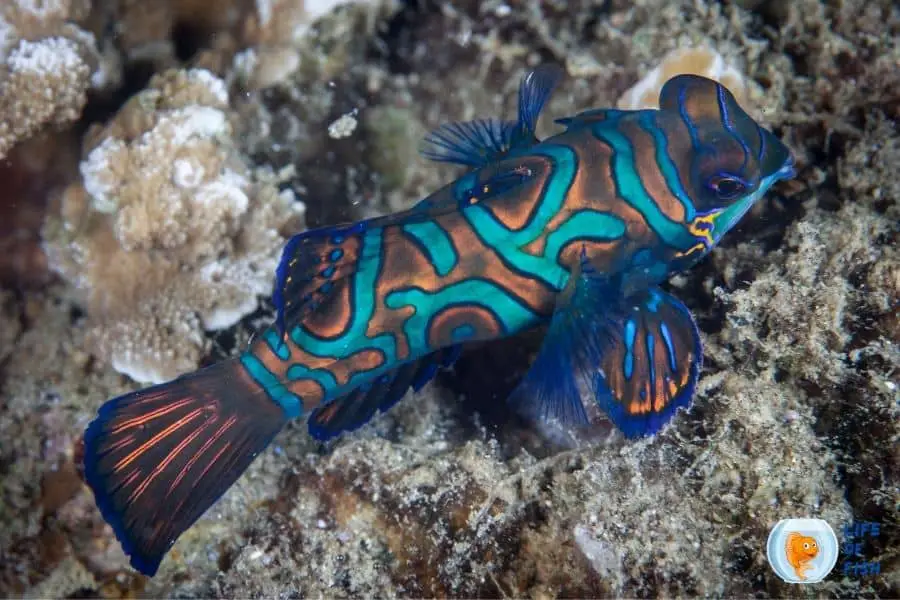
Where Do Mandarin gobies Live?
In the wild, Mandarin gobies are found in coral habitats. Mostly they live in the indo-pacific ocean including, Malaysia, Australia, Indonesia, the Philippines, and the Great Barrier Reef. This fantastic creature mainly lives in shallow lagoons and inshore reefs. Consequently, the rubble beds and dead corals provide home and protection for them.
Do Mandarin Dragonets Need Sand?
Mandarin Dragonets do not need sand. Therefore, tank substrate is not an essential thing for mandarin gobies. So, The bare bottom tank is also okay for them. Moreover, they can live in aquariums that have rockwork as well. But substrate helps to create a more natural feel in captivity. Hence, if you can add substrate to the tank, it is an added advantage to keep your fish happy and healthy.
Do Mandarin Gobies Sift The Sand?
Generally, they do not sift the sand to collect prey. But in captivity, they spend most of their time in the bottom layer of water. Therefore, their movements and swimming behaviors can sift the sand of the tank. But people will misunderstand this behavior as they search for food by shifting sand.
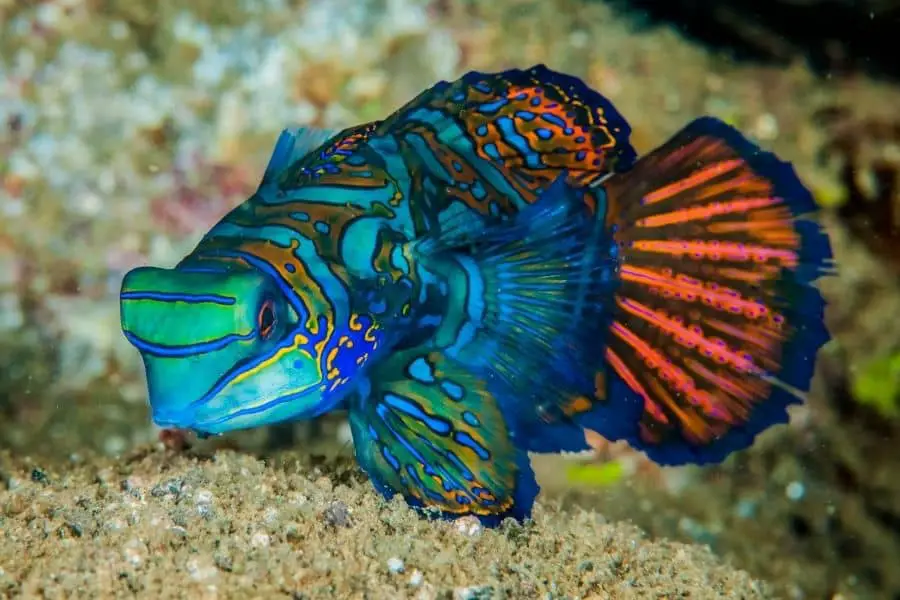
Do Mandarin Gobies Jump?
The simple answer is yes. Mandarin gobies can jump out of your aquarium because of several reasons. If the tank space is not enough or water quality parameters are not matched mandarin gobies can jump out from the tank. Moreover, you should pay attention to your powerhead too. Because upwelling water currents encourage fish to jump out from the tank. Thus, you should provide a gentle flow rate. Dissolved oxygen in the water can be reduced because of several reasons. The overcrowded tank, improper aerator, and high level of nitrogenous waste are the major reasons that reduce the dissolved oxygen of water.
If the tank does not have enough oxygen, mandarin gobies may struggle to absorb oxygen from water. Finally, they try to get out of an uncomfortable environment.
Then they jump out of the aquarium. Thus, you should keep in mind to maintain water quality parameters at an optimum level. Further, you can prevent mandarin goby from jumping by setting up a sealed roof. You practice it for not only the mandarin fish but also all fish varieties. Then it will help to prevent unexpected accidents. Moreover, if there is not enough tank space, arrange a large tank for them. Also, do not add mandarin gobies with the predatory fish.
How Do You Take Care Of A Mandarin Goby?
They are carnivores. Therefore provide suitable diets for mandarin goby such as live copepods and amphipods. Additionally, you can feed them using brine shrimps, Mysis shrimps, and worms too. In addition to that, you should maintain the water quality parameters at ideal levels as below.
Temperature: 75o Fand 81o F
The pH level: 8.1 and 8.4
Salinity: 1.023 to 1.025 specific gravity
Ammonia, Nitrates, Nitrites: at 0 ppm or below 10 ppm
The single mandarin fish needs at least a 30-gallon tank. Thus you should provide enough space for them. Mandarin gobies do not like to live as a group, and males are a bit territorial. Therefore, the mandarin goby pair needs at least 60-gallon space to live healthily and happily. On the other hand, using standard LED light is better for your mandarin fish. Additionally, Mandarin gobies prefer slow-moving water flow. Thus, reduce the flow rate of your powerhead. You can carry out water changes each week to keep pollutant levels low.
Water change plays a major role in maintaining water quality parameters. Further, water replacement gives a refreshing feeling to your fish.
Additionally, you must select suitable tank mates for mandarin gobies. Firefish, green Chromis, and royal gamma are perfect varieties that can live peacefully with mandarin fish. Further, you can add clownfish, coral beauty, and Watchman gobies with your mandarin fish. Proper quarantine practices are also important to prevent diseases. You should follow the correct guidelines when introducing new fish into the main aquarium. Then, it will give healthy and happy fish and aquariums.
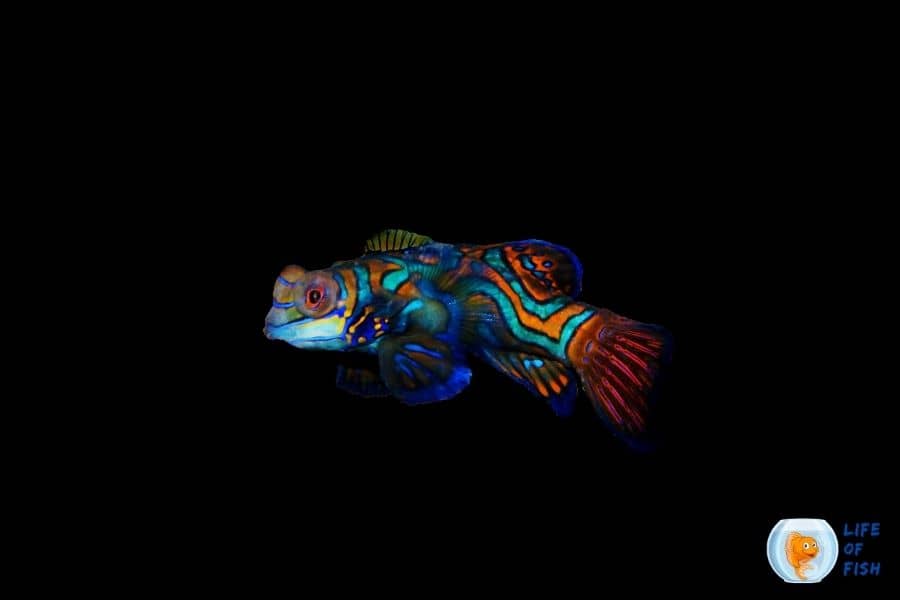
Can Mandarin Dragonets Get Ich?
Mandarin dragonets do not have immunity against the Ich. But, the wonderful factor is they have a thick mucus coat that covers their entire body. It gives good protection for mandarin gobies against the Ich. But the stressed mandarin fish are more susceptible to external parasites such as Ich than normal fish. Because stress directly affects the immunity of the fish.
Can Mandarins Carry Ich?
Mandarin gobies can carry diseases like Ich from the aquarium of the wild environment. Thus, it would be best if you can quarantine them before adding them to the tank. The main symptom of Ich disease is the white spots. These spots may spread on the entire body of fish. Therefore, this disease is also called white spot disease. The protozoan (Cryptocaryon irritans) is the cause initiating Ich or white spot disease.
Are Mandarins Susceptible To Ich?
Mandarin gobies have two types of secretory cells. One cell type produces a thick mucus coating to protect from the elements. Therefore they have some protection against the Ich disease. But they are also vulnerable to Ich. If they are living in preferable conditions, they are not susceptible to Ich. However, when water quality parameters do not suit them or any predatory activities are highly available, they will stress. The stressed mandarin goby is more susceptible to ich than the healthy one.
How Long Do Mandarin Gobies Live?
The Mandarin goby is a small animal that is about 3-4 inches long. They can live around 10-15 years in their natural habitat. If you keep good attention to gobies’ feeds and preferable tank conditions, they may live around 2-4 years in captivity. But their life span in the home aquarium highly depends on the aquarist’s care. Most of the time, they refuse formulated foods. If the fish hobbyist cannot provide live food for them, they will die because of starvation. Thus, do not let them starve.
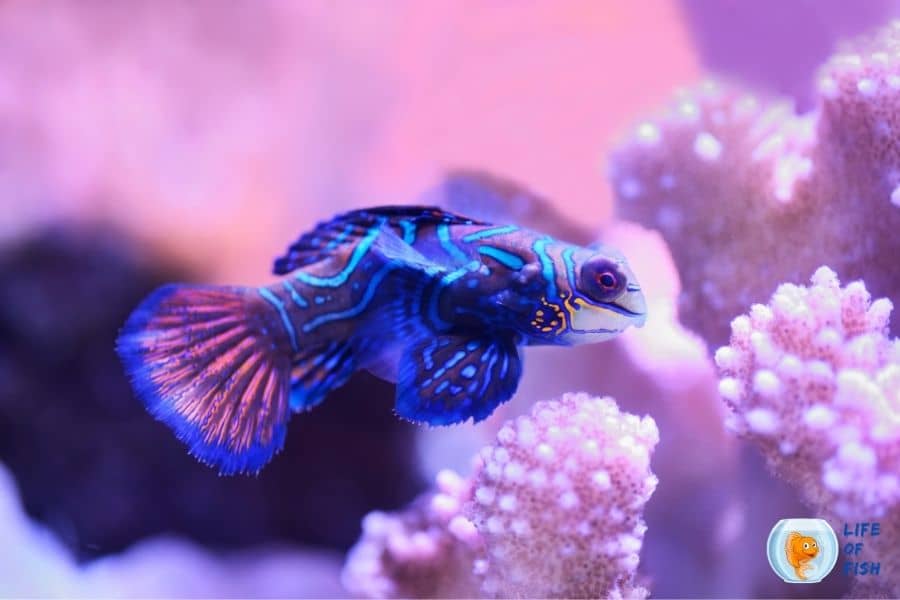
Are Mandarin Gobies Poisonous?
The mandarin fish have two types of cells in its colorful epidermis. One type can produce an outer mucus coat to protect from disease and elements. The other cell type produces a toxin to protect mandarin gobies from predators. Their outer coat contains mucus and toxins. Because of that, touching mandarin fish is a bit dangerous. Moreover, mandarin gobies have an unpleasant smell. Because of those factors, people do not consume it as raw or processed food.
How Do I Know If My Mandarin Goby Is Eating?
It would be best if you gave your attention to the aquarium. Generally, Mandarin goby has a fast metabolism rate. Thus they eat around 16 hours of the day. If there are any live feeds in the tank, they eat one live feed every few seconds. Thus, you can know whether they are eating or not by observing their behaviors. The diseased fish or stressed fish may refuse the feed. If mandarin refuses to feed, you have to pay for extra care for him.
What Type Of Copepod Do Mandarins Eat?
Copepods are invertebrates that have tiny bodies. They are the common live food that is used for many fish species, including Mandarin gobies. Also, they like to eat different types of copepods such as,
- Smaller Tisbe Pods: Tisbe biminensis
- Tigrio pods : Tigriopus californicus
- Amphipods
Further, the mandarin eats worms and large brine shrimps too.
Do Mandarin Fish Eat At Night?
All day and night mandarin gobies are huge grazers. If their stomach is full, they go to sleep at night. But if they are hungry they will try to find food at night time too. Further, the moonlight or night light will help mandarin fish to get food at nighttime.
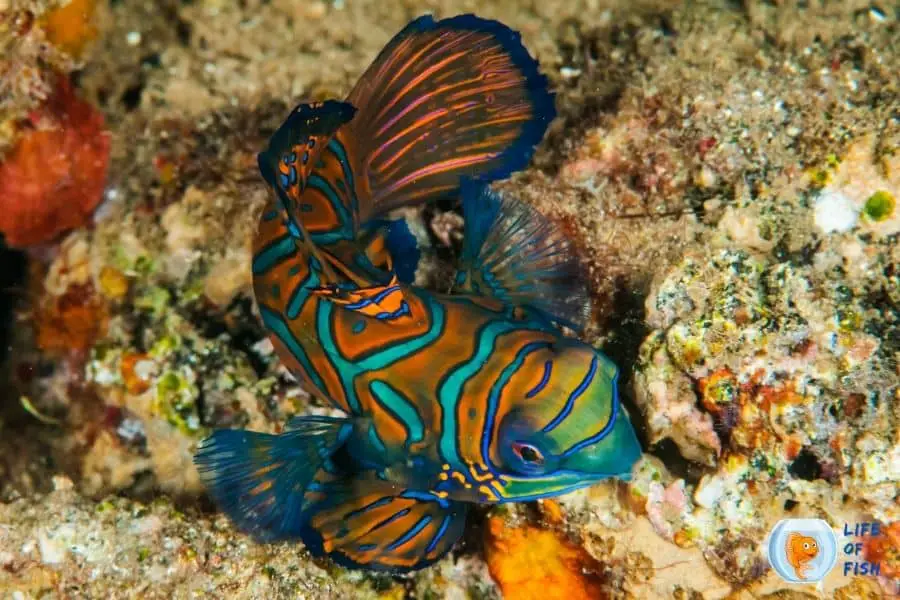
How Do You Keep A Mandarin Goby Alive?
In captivity, you should have good attention to mandarin gobies to keep them alive. There are no secrets to keeping a mandarin goby happily and healthily. The only thing is, you should provide an ideal environment for the mandarin fish that is quietly the same as their natural environment. The tank size, water quality parameters, and fish feed should perfectly match their requirement.
Enough live feed is the critical factor for mandarin fish. If the food does not match their desires, they refuse to eat. Then the goby can die because of starvation. Further, they are fast eaters and eat around 16 hours per day. If you wish to rear mandarin gobies, you should address these feed requirements and pay extra attention to them.
Mandarin gobies do not like to live in a group. Thus, you should add male and female pairs to the reef water tank. Then they will live peacefully and healthily.
Anyhow, If you add two male mandarins together, they will attack each other for territory. Then one fish may die because of stress and starvation. Every earth creature loves to live in their home environment. Mandarin gobies also love to live around coral reefs in their natural habitat. Thus, if you can create a pleasant atmosphere with live corals, it feels better for mandarin gobies.
How Often Should I Feed My Mandarin Goby?
Remember to feed mandarin gobies 2,3 times daily. Add the food amount that the fish can finish within two minutes. If you use some frozen food to feed mandarin, thaw those foods first. Then you can add thawed foods to the aquarium.
Do Mandarin Fish Eat Amphipods?
Mandarin dragonet or mandarin goby is a finicky fish. They eat small crustaceans such as amphipods and copepods. Amphipods generally have laterally compressed bodies and can grow 1mm-340mm in their natural environment. Thus, mandarin gobies can eat amphipods as long as it fits their mouths.
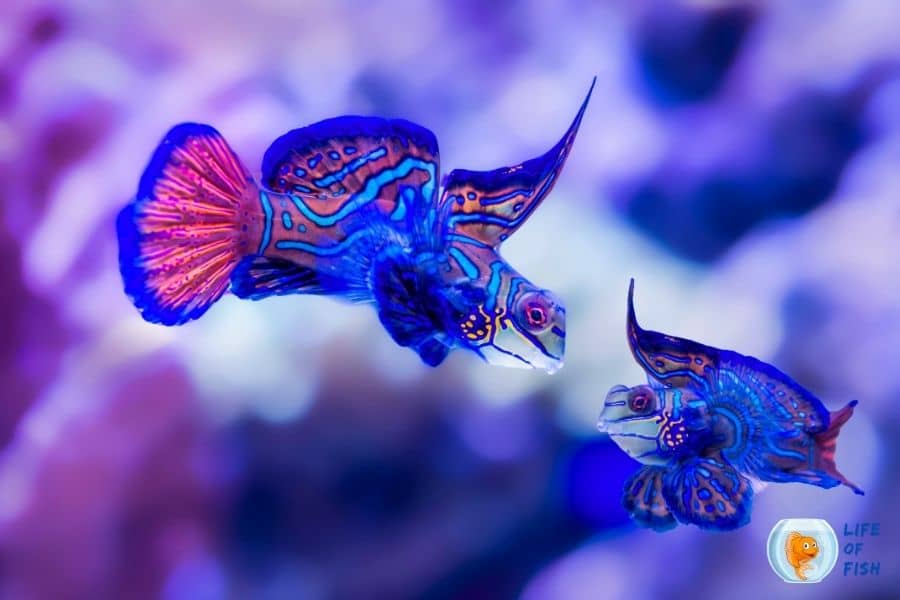
Conclusion
Food and feeding are the primary concerns of any aquarist who wants to keep a Mandarin Dragonet. The most critical thing is providing correct foods to them that are enriched with pods. If you can fulfill this requirement in the right way, Mandarin Goby fish care is fun, easy, and affordable!
Read Next: Are Gourami and Cichlids the same? 12 Interesting Facts
